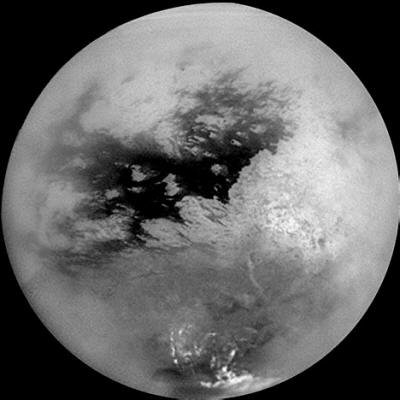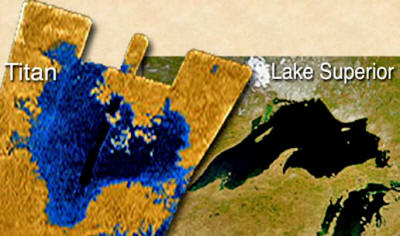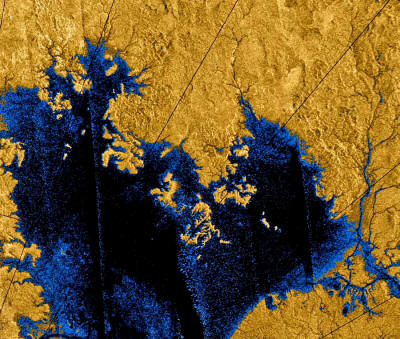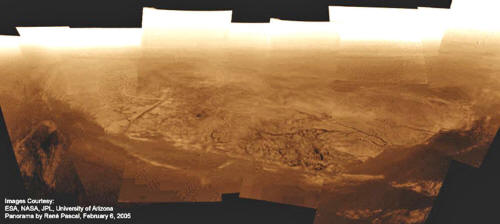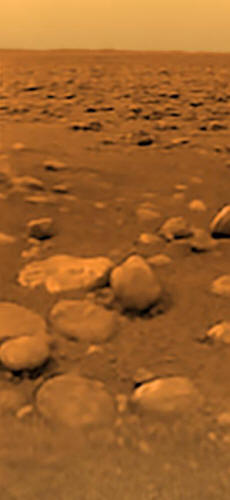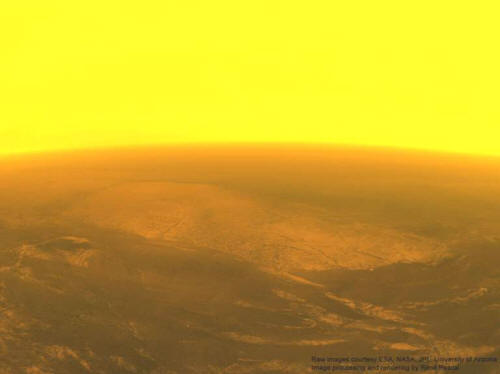|
by Kakha Margiani 2004 from Cosmogeology Website
The mysteries of Saturn, the seventh natural planet from the Sun, have always enticed researchers.
Scientists are perplexed (clue is in the book only) why Saturn, releases more energy than it absorbs from faint sunlight. Titan is also the only moon in the solar system to retain a substantial atmosphere, one even thicker than Earth's.
The Saturnian moon Titan - the ringed planetís largest satellite with a diameter of 5150 kilometers - is a highly complex body in the Solar System. It is larger than the planet Pluto and in many ways more resembles a planet than a moon. It is the only moon in our planetary system with a dense atmosphere, which is one of the reasons why it is of such interest to scientists.
Like the atmosphere of Earth, Titanís atmosphere is mainly composed of the gas nitrogen. This is combined with approximately 3% methane and about 1% argon.
The
Cassini-Huygens spacecraft's first radar
images of Saturn's largest moon, Titan, have revealed a diverse
frozen landscape of bright streaks that may be ice ridges or
wind-driven deposits, and dark regions that are probably smooth
basins (sub-glacial seas and lakes) filled with dirty chemical ice
of methane, ethane, water, etc.
The findings were made using radar measurements of Titan's rotation.
Using data from the radar's early observations, the scientists and radar engineers established the locations of 50 unique landmarks on Titan's surface.
They found that prominent surface features had shifted from their expected positions by up to 30 km. A systematic displacement of surface features would be difficult to explain by other means then asthenosphere existence under crust.
Unless the moon's icy crust was
decoupled from its core by an internal liquid ocean of water making
it easier for the crust to move. It means about 100 km beneath the
chemical ice and lithosphere platforms and organic-rich surface is
an internal fiery ocean of liquid asthenosphere.
Further study of Titan's will let us
understand the watery interior of the seas and lakes better, which
are covered by thick water ice as well as ammonia end hydrocarbon
ices.
Seas and lakes
If it's not a sub-glacial sea, it could
be a sub-glacial lake covered by chemical ices, but that was
impossible, Titan could disappears whole water masses and save the
all other light chemical admixtures.
The Cassini-scientist measurements can
decode surface chemical structure only, but it doesnít mean under
the decoded chemical structure existence of water impossible.
The reason is very simple: astronomersí knowledge is connected to the
wrong theory of the
universe evolution still.
Cosmogeological regulation of the evolution tells another tale. A small space-body has small gravitation and loses whole surrounded gasses, average bodies partially loses gasses and giants-doesnít lose gasses. Main part of the water within the space-body is forming at the initial stage, into the fiery interior as a result of endless chain different chemical reactions.
Other chemical gasses are formed as well, but water is the main product of the chemical reactions, almost into all space-bodies.
Because of chemical properties, liquid water and its icy-crust formation to the last stages is most abundant than hydro carbonate ices. Hydrocarbons admixtures circulation begins after finish of water circulation.
Each admixture needs own conditions for circulation to form rivers, lakes and to be evaporated within atmosphere.
Icy crust, hills, and coastal zone of sub-glacial sea, islands and folding structures.
Now, itís to the final phase of the third stage. In the middle of the third stage, whole Titan was an excellent warm moon. Source of warm were inside and around fiery heavy metals nucleus. Dried river beds are proof about circulation water for hundreds of millions years.
The image is an Earth-like land a lot. Like most Earthís landscape crust-forming events on Titan was almost same. When the temperature of Titanís crust began fluctuation at the 0Oc boundary, that time water - level on Titan had reached to the maximum. After hundreds of millions years water circulation had changed by methane and ethane circulation. There was began endless epoch of glaciations.
Eternal freezing of Titanís crust
sometimes is disturbing by volcano eruption. Volcanic gaseous
streams could melt and evaporate temporally chemical ices and create
temporary chemical rivers as well. Crystals of hydro-carbon ice and
other volcanic admixtures are dispersed on the surface. There are
formed sedimentary thin layers on the land and on the frozen
sub-glacial seas and lakes.
Now the temperature in the high layers Titan is approximately -290įC, and circulation of methane is impossible. Within such conditions, only nitrogen exists within the atmosphere of Titan.
A giant methane-spewing volcano has been spotted in close-up images of Saturn's giant moon Titan.
Rivers on Titan were feeding by the rains, snows, underground waters and glaciers as the Earthsí rivers during warm epoch. There is epoch of sub-glacial seas and lakes by means of absence scared surface.
Existence of the sub-glacial seas
and lakes is connected to the fiery asthenosphere under the crust.
Circulation of water within the atmosphere ceased, after freezing seasí and lakesí surface and later began circulation of methane, ethane and other admixtures.
It means
chemical snowing, chemical raining, chemical rivers and formation of
methane and ethane and other admixturesí frozen layers on the frozen
seas and lakes of water.
On the last phase of the glaciations, the ocean water will freeze till to the ocean bed, to grow up the ice tiles in different heights from the bed seas and lakes. All sub-glacial water under the frozen surface must freeze within the depth about 9 km to increase the ice chunkís height approximately one kilometer.
The seas and lakes surface of Titan has no cracks. That is proof about a thin chemical ice layer on the surface. Water under the ice layers would be conclusive evidence that the geo-evolution within Titan is not over yet. That means the crust-quakes and volcanic eruptions still happen on Titan. There are a lot of huge tracks of aEBa geo-transfers over the crust and is conclusive evidence about formation thick and thin lithosphere platform.
Volcanoes may be either dormant (having no activity) or active (currently erupting) or extinct (no longer active at all).
|

